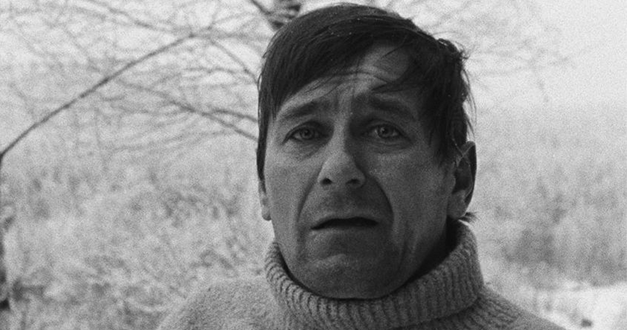
‘Eight Deadly Shots’: A Finnish Film of Fierce Realism
Kristin M. Jones 03/28/2023Made for television in 1972, Mikko Niskanen’s four-part, five-hour work about moonshine-drenched desperation in a rural village is opening in a new restoration at New York’s Film Forum.
In the woods next to a gleaming lake, several men secretly drink moonshine, cook fish and sing songs by a fire in the waning light. It’s one of numerous vivid scenes involving illicit alcohol in “Eight Deadly Shots” (1972), a gripping miniseries by the Finnish actor and director Mikko Niskanen (1929-1990) about desperation and addiction in a rural community, and the events leading up to a shocking crime.
An important work in Finnish film history that deserves wider acclaim, “Eight Deadly Shots” was made for television and also later edited down for theatrical release. The original version, more than five hours long and in four parts, will screen at Film Forum in New York from March 31 to April 6 in a new 4K restoration by the Film Foundation’s World Cinema Project, Yleisradio Oy, Fiction Finland ry and Fondazione Cineteca di Bologna at L’Immagine Ritrovata laboratory. It will also screen at other U.S. venues, including the Cleveland Institute of Art Cinematheque in April and the American Cinematheque in Southern California in June.
Niskanen’s searing tale was inspired by the real-life killing of four police officers by a Finnish farmer, but it is grounded in memories of the rural area where the director was raised. A statement at the beginning of each episode reads in part, “Everyone may have his own truth, but this is the truth I saw and experienced, having been born into these surroundings, having lived this particular life, and having studied these matters.”
Summoning a fierce unity of vision, Niskanen directed, wrote and produced all four episodes, contributed some of the cinematography, and took on the demanding central role of a struggling farmer, Pasi. Tarja-Tuulikki Tarsala played Pasi’s wife, Vaimo, and Paavo Pentikäinen was Pasi’s friend Reiska, but the rest of the cast were nonprofessionals. The settings also convey a compelling realism.
Immediately evoking a powerful sense of place, the first episode opens with views of buildings, vegetation and trees filmed in what seems to be springtime from a vehicle driving on a road as children sing on the soundtrack. The sound of gunfire heralds a cut to the wintry murder scene, followed by glimpses of the funeral service for the victims, the anguished killer in a cell, and his wife and four children silent together at home. And then the film returns to a warmer season, with Pasi again a figure in a landscape holding a gun, but on a day when he shot a bird from a tall tree.

Mikko Niskanen and Paavo Pentikäinen
PHOTO: JANUS FILMS
Guns and alcohol are woven into the plot from the start. Pasi has been sneaking off to make moonshine with Reiska, telling his wife he is going hunting. As the seasons change and he and Vaimo struggle to provide for their family, he returns to drink for camaraderie and fleeting escape. Sometimes trying to outwit authorities seems like a boyishly defiant game, but he can’t elude arrests, fines, unpaid taxes and his own darker impulses.
Alcohol is a release from the sadness of underemployment, but also a family legacy, as Pasi’s father used to drink to excess. “You should stop the moonshining. Nothing good comes out of it,” Vaimo says to him in a moonlit scene in the first episode, when he has come home late. “Yes, I should move on to cognac,” he replies. Over time, his health suffers and marital strife becomes more disastrous. And yet there are moments of tenderness and humor, such as when the family celebrates Christmas by a tree glowing with candles and one of the boys plays Santa.
Scenes showing characters engaging in physical labor are as beautifully filmed as those in which men make and enjoy moonshine. Whether Pasi is energetically working the land or tackling odd jobs in harsh weather, such as logging or digging trenches for sewers, the camera takes in the grueling work and natural landscape like an intensely curious observer.

Tarja-Tuulikki Tarsala
PHOTO: JANUS FILMS
Niskanen’s writing and direction yielded a riveting story. His immersion into the part of Pasi—a character both ordinary and full of contradictions—makes it unforgettable. In Pasi’s most agonizing moments, such as after he drunkenly frightens his family, his face is a haunted mask. Near the end, his features keep slackening, he seems to terrifyingly fold into himself and his behavior is beyond easy explanation.
Playing the part took a physical toll. In a piece on “Eight Deadly Shots” for Film Comment magazine in 2012, the Finnish filmmaker and film historian Peter von Bagh, who made a documentary about Niskanen, wrote that the series was “wrought through friction and adversity, and it’s difficult to see it as anything but savagely independent filmmaking.”
In the second episode, Pasi, Vaimo and their children attend a wedding, an outing they prepare for with poignant anticipation, though Pasi will get drunk again. At this ostensibly hopeful gathering, glances exchanged in the crowd reflect social hierarchies and tensions. As the newlyweds waltz before a sea of faces, the bride reminds the groom that they have to dance, as if they could be Pasi and Vaimo’s younger selves. Out of many such small details, Niskanen built a devastating saga.
Ms. Jones writes about film and culture for the Journal.
Mikko Niskanen, “Eight Deadly Shots” (1972)
Film Forum, NY, 3/31–4/6
The Wall Street Journal